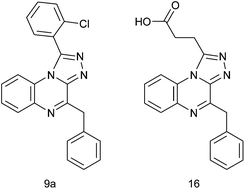A recent publication in MedChemComm from Doaa A. E. Issa et al.reports the synthesis and biological properties of a series of compounds containing the quinoxaline pharmacophore. Their choice of the quinoxaline motif was inspired by the antineoplastic and antimicrobial activity of other compounds containing this group.
Issa et al. synthesised a total of 15 compounds via a key hydrazino intermediate and evaluated 10 candidates at a single high dose for antitumour activity in the National Cancer Institute-60 cell screen. Compounds showing activity were further evaluated in a multi-dose assay. The team went on to assess the in vitro antibacterial activity and antifungal properties.
They found that several compounds in the series display antibacterial activity and one compound possesses both broad spectrum anticancer activity and antimicrobial activity against Pseudomonas aeruginosa.
Design, synthesis and biological evaluation of novel 1,2,4-triazolo and 1,2,4-triazino[4,3-a]quinoxalines as potential anticancer and antimicrobial agents
Doaa A. E. Issa, Nargues S. Habib and Abeer E. Abdel Wahab
Med. Chem. Commun., 2015, DOI: 10.1039/C4MD00257A












![AP39 a novel mitochondria-targeted H2S donor molecule AP39 [(10-oxo-10-(4-(3-thioxo-3H-1,2-dithiol-5-yl)- phenoxy)decyl)triphenylphosphonium bromide] a mitochondria-targeted hydrogen sulfide donor](http://pubs.rsc.org/services/images/RSCpubs.ePlatform.Service.FreeContent.ImageService.svc/ImageService/image/GA?id=C3MD00323J)